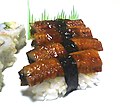Sushi


Template:Contains Japanese text
Sushi (すし, 寿司, 鮨, 鮓, 寿斗, 寿し, 壽司) is a Japanese food consisting of cooked vinegared rice (shari [しゃり]) combined with other ingredients (neta [寿司ネタ]), usually raw fish or other seafood. Neta and forms of sushi presentation vary widely, but the ingredient which all sushi have in common is shari. Shari is also referred to as sushi-meshi (寿司飯, "sushi rice").
Raw meat (usually but not necessarily seafood) sliced and served by itself is sashimi.
History
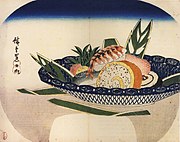
The original type of sushi, known today as nare-zushi (馴れ寿司, 熟寿司,) was first made in Southeast Asia, possibly along what is now known as the Mekong River. The sushi cuisine then spread to Southern China before it was introduced in Japan.[citation needed] The term sushi comes from an archaic grammatical form no longer used in other contexts; literally, sushi means "sour-tasting", a reflection of its historic fermented roots. The oldest form of sushi in Japan, narezushi, still very closely resembles this process, wherein fish is fermented via being wrapped in soured fermenting rice. The fish proteins break down via fermentation into its constituent amino acids. The fermenting rice and fish results in a sour taste and also one of the five basic tastes, called umami in Japanese.[1] In Japan, Contemporary Japanese sushi has little resemblance to the traditional lacto-fermented rice dish. Originally, when the fermented fish was taken out of the rice, only the fish was consumed while the fermented rice was discarded.[2] The strong-tasting and smelling funazushi, a kind of narezushi made near Lake Biwa in Japan, resembles the traditional fermented dish. Beginning in the Muromachi period (AD 1336–1573) of Japan, vinegar was added to the mixture for better taste and preservation. The vinegar accentuated the rice's sourness and was known to increase its shelf life, allowing the fermentation process to be shortened and eventually abandoned. In the following centuries, sushi in Osaka evolved into oshi-zushi. The seafood and rice were pressed using wooden (usually bamboo) molds. By the mid 18th century, this form of sushi had reached Edo (contemporary Tokyo).[3]
The contemporary version, internationally known as "sushi", was created by Hanaya Yohei (1799–1858) at the end of the Edo period in Edo. Sushi invented by Hanaya was an early form of fast food that was not fermented (therefore prepared quickly) and could be conveniently eaten with one's hands.[3] Originally, this sushi was known as Edomae zushi because it used freshly caught fish in the Edo-mae (Edo Bay or Tokyo Bay). Though the fish used in modern sushi no longer usually comes from Tokyo Bay, it is still formally known as Edomae nigirizushi.
The Oxford English Dictionary notes the earliest written mention of sushi in English in an 1893 book, A Japanese Interior, where it mentions sushi as "a roll of cold rice with fish, sea-weed, or some other flavoring".[4][5] However, there is also mention of sushi in a Japanese-English dictionary from 1873,[6] and an 1879 article on Japanese cookery in the journal Notes and Queries.[7]
Types
The common ingredient across all kinds of sushi is vinegared sushi rice. Variety arises from fillings, toppings, condiments, and preparation. Traditional versus contemporary methods of assembly may create very different results from very similar ingredients.[8] In spelling sushi, its first letter s is replaced with z when a prefix is attached, as in nigirizushi, due to consonant mutation called rendaku in Japanese.
Chirashizushi

Chirashizushi (ちらし寿司, "scattered sushi") is a bowl of sushi rice topped with a variety of sashimi and garnishes (also refers to barazushi). Edomae chirashizushi (Edo-style scattered sushi) is an uncooked ingredient that is arranged artfully on top of the sushi rice in a bowl. Gomokuzushi (Kansai-style sushi) consists of cooked or uncooked ingredients mixed in the body of rice in a bowl. There is no set formula for the ingredients; they are either chef's choice or specified by the customer. It is commonly eaten because it is filling, fast and easy to make. Chirashizushi often varies regionally. It is eaten annually on Hinamatsuri in March.
Inarizushi
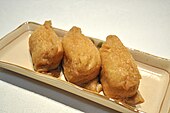
Inarizushi (稲荷寿司) is a pouch of fried tofu typically filled with sushi rice alone. It is named after the Shinto god Inari, who is believed to have a fondness for fried tofu. The pouch is normally fashioned as deep-fried tofu (油揚げ, abura age). Regional variations include pouches made of a thin omelette (帛紗寿司, fukusa-zushi, or 茶巾寿司, chakin-zushi). It should not be confused with inari maki, which is a roll filled with flavored fried tofu.
A version of inarizushi that includes green beans, carrots, and gobo along with rice, wrapped in a triangular aburage (fried tofu) piece, is a Hawaiian specialty, where it is called cone sushi and is often sold in okazu-ya (Japanese delis) and as a component of bento boxes.[9][10][11][12]
Makizushi


Makizushi (巻き寿司, "rolled sushi"), Norimaki (海苔巻き, "Nori roll") or Makimono (巻物, "variety of rolls") is a cylindrical piece, formed with the help of a bamboo mat, called a makisu (巻簾). Makizushi is generally wrapped in nori (seaweed), but is occasionally wrapped in a thin omelette, soy paper, cucumber, or shiso (perilla) leaves. Makizushi is usually cut into six or eight pieces, which constitutes a single roll order. Below are some common types of makizushi, but many other kinds exist.
Futomaki (太巻, "thick, large or fat rolls") is a large cylindrical piece, with nori on the outside.[13] A typical futomaki is five to six centimeters (2–2.5 in) in diameter.[14] They are often made with two, three, or more fillings that are chosen for their complementary tastes and colors. During the evening of the Setsubun festival, it is traditional in the Kansai region to eat uncut futomaki in its cylindrical form, where it is called ehō-maki (恵方巻, lit. happy direction rolls).[15] By 2000 the custom had spread to all of Japan.[16] Futomaki are often vegetarian, and may utilize strips of cucumber, kampyō gourd, takenoko bamboo shoots, or lotus root. Strips of tamagoyaki omelette, tiny fish roe, chopped tuna, and oboro whitefish flakes are typical non-vegetarian fillings.[13]
Hosomaki (細巻, "thin rolls") is a small cylindrical piece, with the nori on the outside. A typical hosomaki has a diameter of about two and a half centimeters (1 in).[14] They generally contain only one filling, often tuna, cucumber, kanpyō, thinly sliced carrots, or, more recently, avocado. Kappamaki, (河童巻) a kind of Hosomaki filled with cucumber, is named after the Japanese legendary water imp fond of cucumbers called the kappa. Traditionally, Kappamaki is consumed to clear the palate between eating raw fish and other kinds of food, so that the flavors of the fish are distinct from the tastes of other foods. Tekkamaki (鉄火巻) is a kind of Hosomaki filled with raw tuna. Although it is believed that the name "Tekka", meaning 'red hot iron', alludes to the color of the tuna flesh or salmon flesh, it actually originated as a quick snack to eat in gambling dens called "Tekkaba" (鉄火場), much like the sandwich.[17][18] Negitoromaki (ねぎとろ巻) is a kind of Hosomaki filled with scallion (negi) and chopped tuna (toro). Fatty tuna is often used in this style. Tsunamayomaki (ツナマヨ巻) is a kind of Hosomaki filled with canned tuna tossed with mayonnaise.
Temaki (手巻, "hand roll") is a large cone-shaped piece of nori on the outside and the ingredients spilling out the wide end. A typical temaki is about ten centimeters (4 in) long, and is eaten with fingers because it is too awkward to pick it up with chopsticks. For optimal taste and texture, Temaki must be eaten quickly after being made because the nori cone soon absorbs moisture from the filling and loses its crispness and becomes somewhat difficult to bite. For this reason, the nori in pre-made or take-out temaki is sealed in plastic film which is removed immediately before eating.[19]
Uramaki (裏巻, "inside-out roll") is a medium-sized cylindrical piece with two or more fillings. Uramaki differs from other makimono because the rice is on the outside and the nori inside. The filling is in the center surrounded by nori, then a layer of rice, and an outer coating of some other ingredients such as roe or toasted sesame seeds. It can be made with different fillings, such as tuna, crab meat, avocado, mayonnaise, cucumber or carrots. In Japan, urimaki is an uncommon type of makimono because of the outer layer of rice can be quite difficult to handle with fingers.[20]
Narezushi

Narezushi (熟れ寿司, "matured sushi") is a traditional form of fermented sushi. Skinned and gutted fish are stuffed with salt, placed in a wooden barrel, doused with salt again, then weighed down with a heavy tsukemonoishi (pickling stone). As days pass, water seeps out and is removed. After six months, this sushi can be eaten, remaining edible for another six months or more.[21] The most famous variety of narezushi still being produced is funa-zushi (made from fish of the crucian carp genus, authentically from C. auratus grandoculis (error: {{nihongo}}: Japanese or romaji text required (help)) endemic to Lake Biwa), a typical dish of Shiga Prefecture.
Nigirizushi
Nigirizushi (握り寿司, "hand-pressed sushi") consists of an oblong mound of sushi rice that the chef presses into a small rectangular box between the palms of the hands, usually with a bit of wasabi, and a topping (the neta) draped over it. Neta are typically fish such as salmon, tuna or other seafood. Certain toppings are typically bound to the rice with a thin strip of nori, most commonly octopus (tako), freshwater eel (unagi), sea eel (anago), squid (ika), and sweet egg (tamago). When ordered separately, nigiri is generally served in pairs.[original research?] A sushi set (a sampler dish) may contain only one piece of each topping.[original research?]

Gunkanmaki (軍艦巻, "warship roll") is a special type of nigirizushi: an oval, hand-formed clump of sushi rice that has a strip of "nori" wrapped around its perimeter to form a vessel that is filled with some soft, loose or fine-chopped ingredient that requires the confinement of nori such as roe, nattō, oysters, sea urchin, corn with mayonnaise, and quail eggs. Gunkan-maki was invented at the Ginza Kyubey restaurant in 1941;[22][23] its invention significantly expanded the repertoire of soft toppings used in sushi.[citation needed]
Temarizushi (手まり寿司, "ball sushi") is a ball-shaped sushi made by pressing rice and fish into a ball-shaped form by hand using a plastic wrap.[citation needed]
Oshizushi

Oshizushi (押し寿司, "pressed sushi"), also known as 箱寿司, hako-zushi, "box sushi"), is a pressed sushi from the Kansai region, a favorite and specialty of Osaka. A block-shaped piece formed using a wooden mold, called an oshibako. The chef lines the bottom of the oshibako with the toppings, covers them with sushi rice, and then presses the lid of the mold down to create a compact, rectilinear block. The block is removed from the mold and then cut into bite-sized pieces. Particularly famous is バッテラ (battera, pressed mackerel sushi) or 鯖寿司 (saba zushi).[24]
Western-style sushi
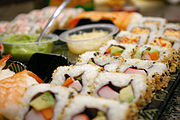
The increasing popularity of sushi around the world has resulted in variations typically found in the Western world, but rarely in Japan (a notable exception to this is the use of salmon which was introduced by the Norwegians in the early 1980's[25]). Such creations to suit the Western palate[20] were initially fueled by the invention of the California roll. A wide variety of popular rolls has evolved since. Though the menu names of dishes often vary by restaurant, some examples include:
| Sushi roll name | Definition |
|---|---|
| Alaska roll | a variant of the California roll with raw salmon on the inside, or layered on the outside. |
| B.C. roll British Columbia roll | contains grilled or barbecued salmon skin, cucumber, sweet sauce, sometimes with roe. Also sometimes referred to as salmon skin rolls outside of British Columbia, Canada. |
| California roll | consists of avocado, kani kama (imitation crab/crab stick) (also can contain real crab in 'premium' varieties), cucumber and tobiko, often made uramaki (with rice on the outside, nori on the inside) |
| Dynamite roll | includes yellowtail (hamachi) and/or prawn tempura, and fillings such as bean sprouts, carrots, avocado, cucumber, chili, spicy mayonnaise, and roe. |
| Hawaiian roll | contains shoyu tuna (canned), tamago, kanpyō, kamaboko, and the distinctive red and green hana ebi (shrimp powder). |
| Philadelphia roll | consists of raw or smoked salmon, cream cheese (often Philadelphia cream cheese brand), cucumber or avocado, and/or onion. |
| Rainbow roll | is a California roll with typically 6–7 types of sashimi (yellowtail, tuna, salmon, snapper, white fish, eel, etc.) and avocado wrapped around it. |
| Seattle roll | consists of cucumber, avocado, and raw or smoked salmon. |
| Mango roll | includes fillings such as avocado, crab meat, tempura shrimp, mango slices, and topped off with a creamy mango paste. |
| Spider roll | includes fried soft-shell crab and other fillings such as cucumber, avocado, daikon sprouts or lettuce, roe, and sometimes spicy mayonnaise. |
| Michigan roll | includes fillings such as spicy tuna, smelt roe, spicy sauce, avocado, and sushi rice. Is a variation on Spicy Tuna Roll. |
Other rolls may include chopped scallops, spicy tuna, beef or chicken teriyaki roll, okra, and assorted vegetables such as cucumber and avocado. Sometimes sushi rolls are made with brown rice and black rice, which appear in Japanese cuisine as well. An inside-out roll allows the consumer to drape sashimi on top of the entire roll. Examples include the rainbow roll (an inside-out topped with thinly sliced maguro, hamachi, ebi, sake and avocado) and the caterpillar roll (an inside out topped with thinly sliced avocado). Also commonly found is the rock and roll (an inside out roll with barbecued freshwater eel and avocado with toasted sesame seeds on the outside) and the tempura roll where shrimp tempura is in the roll or an entire roll is battered and fried tempura style. In the Southern United States, many sushi restaurants prepare rolls using crawfish. Futomaki roll is found widely within Japan and is often mistaken for California roll. Other types of Western-style sushi are also rarely seen in Japan.
Ingredients
All sushi has a base of specially prepared rice, complemented with other ingredients.
Sushi-meshi
Sushi-meshi 鮨飯 or Su-meshi 酢飯 is a preparation of white, short-grained, Japanese rice mixed with a dressing consisting of rice vinegar, sugar, salt, and occasionally kombu and sake. The rice also called shari 舎利 or gohan ご飯. It has to be cooled to room temperature before being used for a filling in a sushi or else it will get too sticky while being seasoned. Traditionally, the mixing is done with a hangiri, which is a round, flat-bottom wooden tub or barrel, and a wooden paddle (shamoji).
Sushi rice is prepared with short-grain Japanese rice, which has a consistency that differs from long-grain strains such as those from India, Pakistan, Thailand, and Vietnam. The essential quality is its stickiness or glutinousness. Freshly harvested rice (shinmai) typically contains too much water, and requires extra time to drain the rice cooker after washing. In some fusion cuisine restaurants, short grain brown rice and wild rice are also used.
There are regional variations in sushi rice and, of course, individual chefs have their individual methods. Most of the variations are in the rice vinegar dressing: the Kantō region (or East Japan) version of the dressing commonly uses more salt; in Kansai region (or West Japan), the dressing has more sugar.
Nori

The black seaweed wrappers used in makimono are called nori. Nori is a type of algae, traditionally cultivated in the harbors of Japan. Originally, algae was scraped from dock pilings, rolled out into thin, edible sheets, and dried in the sun, in a process similar to making rice paper. Today, the commercial product is farmed, processed, toasted, packaged, and sold in sheets.
The size of a nori sheet influences the size of maki-mono.[citation needed] A full size sheet produces futomaki, and a half produces hosomaki and temaki.[citation needed] To produce gunkan and some other makimono, an appropriately sized piece of nori is cut from a whole sheet.[citation needed]
Nori by itself is an edible snack and is available with salt or flavored with teriyaki sauce. The flavored variety, however, tends to be of lesser quality and is not suitable for sushi.[citation needed]
When making fukusazushi, a paper-thin omelette may replace a sheet of nori as the wrapping. The omelette is traditionally made on a rectangular omelette pan (makiyakinabe), and used to form the pouch for the rice and fillings.[citation needed]
Neta

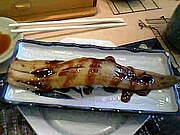
For culinary, sanitary, and aesthetic reasons, the minimum quality and freshness of fish to be eaten raw must be superior to that of fish which is to be cooked.[citation needed] Sushi chefs are trained to recognize important attributes, including smell, color, firmness, and freedom from parasites that may go undetected in commercial inspection.[citation needed] Commonly used fish are tuna (maguro, shiro-maguro), Japanese amberjack, yellowtail (hamachi), snapper (kurodai), mackerel (saba), and salmon (sake). The most valued sushi ingredient is toro, the fatty cut of the fish. This comes in a variety of ōtoro (often from the bluefin species of tuna) and chūtoro, meaning ‘middle toro’, implying that it is halfway into the fattiness between toro and the regular cut. Aburi style refers to nigiri sushi where the fish is partially grilled (topside) and partially raw. Most nigiri sushi will be completely raw.[citation needed]
Other seafoods such as squid (ika), eel (anago and unagi), pike conger (hamo), octopus (tako), shrimp (ebi and amaebi), clam (mirugai, aoyagi and akagai), fish roe (ikura, masago, kazunoko and tobiko), sea urchin (uni), crab (kani), and various kinds of shellfish (abalone, prawn, scallop) are the most popular seafoods in sushi. Oysters, however, are less common, as the taste is not thought to go well with the rice. Kani kama, or imitation crab stick, is commonly substituted for real crab, most notably in California rolls.[citation needed]

Pickled daikon radish (takuan) in shinko maki, pickled vegetables (tsukemono), fermented soybeans (nattō) in nattō maki, avocado, cucumber in kappa maki, asparagus, yam, pickled ume (umeboshi), gourd (kanpyō), burdock (gobo), and sweet corn (possibly mixed with mayonnaise) are also used in sushi.[citation needed]
Tofu and eggs (in the form of slightly sweet, layered omelette called tamagoyaki and raw quail eggs ride as a gunkan-maki topping) are common.[citation needed]

Condiments
Sushi is commonly eaten with condiments. Sushi may be dipped in shōyu, soy sauce, and may be flavored with wasabi, a piquant paste made from the grated root of the Wasabia japonica plant. Japanese-style mayonnaise is a common condiment in Japan on salmon, pork and other sushi cuts.
True wasabi has anti-microbial properties and may reduce the risk of food poisoning.[26] The traditional grating tool for wasabi is a sharkskin grater or samegawa oroshi. An imitation wasabi (seiyo-wasabi), made from horseradish, mustard powder and green dye is common. It is found at lower-end kaiten zushi restaurants, in bento box sushi and at most restaurants outside Japan. If manufactured in Japan, it may be labelled "Japanese Horseradish".[27]
Gari (sweet, pickled ginger) is eaten with sushi to both cleanse the palate and aid in digestion. In Japan, green tea (ocha) is invariably served together with sushi. Better sushi restaurants often use a distinctive premium tea known as mecha. In sushi vocabulary, green tea is known as agari.
Sushi may be garnished with Gobo, grated daikon radish, thinly sliced vegetables, carrots/radishes/cucumbers that have been shaped to look like flowers, real flowers and/or seaweed salad.[28]
Nutrition

The main ingredients of traditional Japanese sushi, raw fish and rice, are naturally low in fat, high in protein, carbohydrates, vitamins, and minerals, as are gari and nori. Other vegetables wrapped within the sushi also offer various vitamins and minerals. Many of the seafood ingredients also contain omega-3 fatty acids, which have a variety of health benefits.
Health risks
Some of the ingredients in sushi can present health risks. Large marine apex predators such as tuna (especially bluefin) can harbor high levels of methylmercury, which can lead to mercury poisoning when consumed in large quantity[29] or when consumed by certain higher-risk groups including women who might get pregnant, pregnant women, nursing mothers and young children.[30]
Sashimi or other types of sushi containing raw fish present a risk of infection by three main types of parasites:
- Clonorchis sinensis a fluke which can cause clonorchiasis[31]
- Anisakis, a roundworm which can cause anisakiasis[32]
- Diphyllobothrium, a tapeworm which can cause diphyllobothriasis[33]
For the above reasons, the EU regulations forbids the use of fresh raw fish. It must be frozen at temperatures below −20 °C (−4 °F) in all parts of the product for no less than 24 hours.[34] As such, a number of fishing boats, suppliers and end users "super freeze" fish for sushi to temperatures as low at −60°C.[35] As well as parasite destruction, super freezing also prevents oxidation of the blood in tuna flesh thus preventing the discoloration that happens at temperatures above −20°C.[36]
Some forms of sushi, notably those containing pufferfish fugu and some kinds of shellfish, can cause severe poisoning if not prepared properly. Particularly, fugu has a lethal dose of tetrodotoxin in its internal organs and must be prepared by a licensed fugu chef who has passed the prefectural examination in Japan.[37] The licensing examination process consists of a written test, a fish-identification test, and a practical test, preparing and eating the fish. Only about 35 percent of the applicants pass, and in rare cases, death results.[38] [failed verification] The Emperor of Japan is forbidden to eat fugu, as it is considered too risky.[39]
Presentation
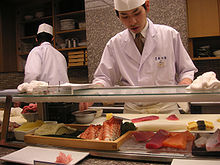
Traditionally, sushi is served on minimalist Japanese-style, geometric, mono- or duo-tone wood or lacquer plates, in keeping with the aesthetic qualities of this cuisine.[citation needed]
Many sushi restaurants offer fixed-price sets, selected by the chef from the catch of the day. These are often graded as shō-chiku-bai (松竹梅), shō/matsu (松, pine), chiku/take (竹, bamboo) and bai/ume), with matsu the most expensive and ume the cheapest.[citation needed]
Sushi may be served kaiten zushi (sushi train) style. Color-coded plates of sushi are placed on a conveyor belt; as the belt passes customers choose as they please. After finishing, the bill is tallied by counting how many plates of each color have been taken. Newer kaiten zushi restaurants use barcodes or RFID tags embedded in the dishes to manage elapsed time after the item was prepared.[citation needed]
Glossary
Some specialized or slang terms are used in the sushi culture. Most of these terms are used only in sushi bars.
- Agari: "Rise up" Green tea. Ocha (お茶) in usual Japanese.
- Gari: Sweet, pickled and sliced ginger, or sushi ginger. Shoga (生姜) in standard Japanese.
- Gyoku: "Jewel", Sweet and cubic-shaped omelette. Tamagoyaki (卵焼, 玉子焼 in standard Japanese.)
- Murasaki: Soy sauce. Murasaki is the color name for violet or purple. Shoyu (醤油) in standard Japanese.
- Neta: Toppings on nigiri or fillings in makimono. Ne-ta is from reversal of ta-ne. Tane (種) in standard Japanese.
- Oaiso: "Compliment", Bill or check. Oaiso may be used in not only sushi bars but also izakaya.[40][41] Okanjo or chekku (お勘定) in standard Japanese.
- Otemoto: Chopsticks. Otemoto means the nearest thing from the customer seated. Hashi (箸) or ohashi in standard Japanese.
- Sabi: Japanese horseradish. Contracted form of wasabi (山葵).
- Shari: Vinegar rice or rice. It may originally be from Sanskrit (zaali शालि) meaning rice and/or Śarīra. Gohan (ご飯) or meshi (飯) in standard Japanese.
- Tsume: Sweet thick sauce mainly made of soy sauce. Nitsume (煮詰め) in standard Japanese.
Etiquette
Unlike sashimi, which is almost always eaten with chopsticks, nigirizushi is traditionally eaten with the fingers, even in formal settings.[42] While it is commonly served on a small platter with a side dish for dipping, sushi can also be served in a bento, a box with small compartments that hold the various dishes of the meal.
Soy sauce is the usual condiment, and sushi is normally served with a small sauce dish, or a compartment in the bento. Traditional etiquette suggests that the sushi is turned over so that only the topping is dipped; this is because the soy sauce is for flavoring the topping, not the rice, and because the rice would absorb too much soy sauce and would fall apart.[43] If it is difficult to turn the sushi upside-down, one can baste the sushi in soy sauce using gari (sliced ginger) as a brush. Toppings which have their own sauce (such as eel) should not be eaten with soy sauce.
Traditionally, the sushi chef will add an appropriate amount of wasabi to the sushi while preparing it, and etiquette suggests eating the sushi as is, since the chef is supposed to know the proper amount of wasabi to use. However, today wasabi is more a matter of personal taste, and even restaurants in Japan may serve wasabi on the side for customers to use at their discretion, even when there is wasabi already in the roll.[44]
| Utensil | Definition |
|---|---|
| Fukin | Kitchen cloth |
| Hangiri | Rice barrel |
| Hocho | Kitchen knives |
| Makisu | Bamboo rolling mat |
| Ryoribashi | Cooking chopsticks |
| Shamoji | Wooden rice paddle |
| Makiyakinabe | Rectangular omelette pan |
| Oshizushihako | a mold used to make oshizushi |
Gallery
-
Edomae nigiri (江戸前握り)
-
Ebi nigiri sushi (海老握り)
-
Salmon nigiri (鮭握り)
-
Toro (fatty tuna belly) nigiri (鮪とろ握り)
-
Salmon roll (巻き鮭)
-
Kakinoha (persimmon leaf) sushi (柿の葉寿司)
-
Chakin-sushi, wrapped in thin omelette. (茶巾寿司)
-
Sushi plate (盛り合わせ)
-
Ikura gunkan-maki (イクラ軍艦巻き)
-
Sasa (bamboo leaf) sushi (笹寿司)
-
Unagi (teriyaki-roasted freshwater eel) sushi (鰻寿司)
-
Nigirizushi for sale at a supermarket in Tokyo
-
Assorted sushi (盛り合わせ)
-
Assorted Western sushi (盛り合わせ)
-
Western California roll and tuna roll in uramaki (カリフォルニア巻き)
-
Western spicy tuna hand roll (スパイシーツナロール)
-
Western spicy shrimp roll (スパイシー海老ロール)
-
Salmon sushi next to a piece of a vegetarian sushi
See also
- Gimbap, a Korean dish
- Itadakimasu, Japanese dining etiquette
- Nyotaimori, female body presentation of sushi
- Sashimi bōchō, a Japanese knife to slice raw fish and seafood
References
- ^ Kouji ITOU; Shinsuke KOBAYASHI; Tooru OOIZUMI; Yoshiaki AKAHANE (2006). "Changes of proximate composition and extractive components in narezushi, a fermented mackerel product, during processing". Fisheries Science. 72 (6): 1269–1276. doi:10.1111/j.1444-2906.2006.01285.x.
- ^ Hill, Amelia (2007-10-08). "Chopsticks at dawn for a sushi showdown". London: The Guardian. Retrieved 25 September 2011.
- ^ a b Zschock, Day. The Little Black Book of Sushi: The Essential Guide to the World of Sushi. Page 14-15. 2005. ISBN 1-59359-961-7.
- ^ "Sushi", Oxford English Dictionary, Second edition, 1989; online version December 2011. Accessed 23 December 2011.
- ^ Bacon, Alice Mabel (1893). A Japanese interior. Houghton, Mifflin and Company. p. 271.
p.271: Sushi, a roll of cold rice with fish, sea-weed, or some other flavoring
p.181: While we were waiting for my lord and my lady to appear, domestics served us with tea and sushi or rice sandwiches, and the year-old baby was brought in and exhibited.
p.180: All the sushi that I had been unable to eat were sent out to my kuruma, neatly done up in white paper. - ^ James Curtis Hepburn, Japanese-English and English-Japanese dictionary, Publisher: Randolph, 1873, 536 pages (page 262)
- ^ W.H. Patterson, "Japanese Cookery", Notes and queries, Publisher: Oxford University Press, 1879. (p.263)
- ^ Kawasumi, Ken (2001). The Encyclopedia of Sushi Rolls. Graph-Sha. ISBN 4-88996-076-7.
- ^ Ann Kondo Corum, Ethnic Foods of Hawaii (2000). Bess Press: p. 54.
- ^ Betty Shimabukuro, "Yama's Fish Market offers more than fish (March 20, 2002). Honolulu Star-Bulletin.
- ^ Joan Namkoong, Go Home, Cook Rice: A Guide to Buying and Cooking the Fresh Foods of Hawaii (2001). Ness Press: p. 8.
- ^ Joan Namkoong, Food Lover's Guide to Honolulu (2006), Bess Press, p. 37.
- ^ a b Ōmae, Kinjirō; Tachibana, Yuzuru (1988). The book of sushi (1st paperback ed.). Tokyo: Kōdansha International. p. 70. ISBN 9780870118661. OCLC 18925025.
- ^ a b Strada, Judi; Moreno, Mineko Takane (2004). Sushi for dummies. John Wiley & Sons. ISBN 0-7645-4465-9.
Sliced sushi rolls are traditionally made in three different sizes, or diameters: thin 1-inch rolls (hoso-maki); medium 1 1/2-inch rolls (chu-maki); and thick 2 to 2 1/2-inch rolls (futo-maki).""
- ^ "Setsubun [節分]". Heisei Nippon seikatsu benrichō [平成ニッポン生活便利帳] (in Japanese). Tokyo: Jiyū Kokuminsha. 2012. Retrieved 2012-05-26.
- ^ "Ehō-maki". Dijitaru daijisen (in Japanese). Tokyo: Shogakukan. 2012. Retrieved 2012-05-26.
- ^ Andy Bellin (2005). "Poker Night in Napa". Food & Wine.
{{cite journal}}: Unknown parameter|month=ignored (help) - ^ Ryuichi Yoshii, "Tuna rolls (Tekkamaki)", Sushi, p. 48 (1999), Tuttle Publishing, ISBN 962-593-460-X.
- ^ "Packaging For Temaki Sushi". Gpe.dk. Retrieved 2012-11-07.
- ^ a b "Types of Sushi". SushiMasters. Retrieved 2008-07-26.
- ^ Hosking, Richard (1997). A Dictionary of Japanese Food: Ingredients & Culture. Tuttle Publishing. p. 222. ISBN 978-0-8048-2042-4. Retrieved 26 January 2011.
- ^ Chad Hershler (2005). "Sushi Then and Now". The Walrus.
{{cite journal}}: Unknown parameter|month=ignored (help) - ^ (ja) 軍カン巻の由来, お寿し大辞典 > お寿し用語集, 小僧寿しチェーン.
- ^ Ashkenazi, Michael (2000). The essence of Japanese cuisine: an essay on food and culture. University of Pennsylvania Press. p. 231. ISBN 0-8122-3566-5.
Called saba zushi or battera, after the Portuguese term for "small boat", which the mould resembles.
{{cite book}}:|first2=missing|last2=(help); Missing pipe in:|first2=(help)CS1 maint: numeric names: authors list (link) - ^ "Norway's Introduction of Salmon Sushi to Japan". NorwegianSalmonIntroduction.
- ^ Shin, I.S. (2004). "Bactericidal activity of wasabi (Wasabia japonica) against Helicobacter pylori". Int J Food Microbiol. 94 (3): 255–61. doi:10.1016/S0168-1605(03)00297-6. PMID 15246236.
{{cite journal}}: Unknown parameter|coauthors=ignored (|author=suggested) (help); Unknown parameter|month=ignored (help) - ^ Shimbo, Hiroko (2000). The Japanese Kitchen. Harvard Common Press. ISBN 1-55832-176-4.
- ^ http://google.com/
- ^ Burros, Marian (2008-01-23). "High Mercury Levels Are Found in Tuna Sushi". The New York Times.
- ^ "Methylmercury: What You Need to Know About Mercury in Fish and Shellfish". Food and Drug Administration. 2004-03-01. Retrieved 2012-09-18.
- ^ "Clonorchis sinensis – Material Safety Data Sheets (MSDS)". Public Health Agency of Canada. 2011-02-18. Retrieved 2012-09-18.
- ^ "Parasites – Anisakiasis". Centers for Disease Control and Prevention. 2010-11-02. Retrieved 2012-09-18.
- ^ Dugdale, DC (2011-08-24). "Fish tapeworm". MedlinePlus. Retrieved 2012-09-18.
- ^ European Parliament (2004-04-30). "Regulation (EC) No 853/2004 of The European Parliament and of the Council of 29 April 2004 laying down specific hygiene rules for on the hygiene of foodstuffs" (pdf). Official Journal of the European Union. 139 (55): 133.
- ^ Issenberg, Sasha (2008). The sushi economy : globalization and the making of a modern delicacy. New York: Gotham. ISBN 1592403638.
- ^ Macfarlane, Alex. "The Truth About Sushi Fish". Everything Sushi Blog Interview. Retrieved 3 December 2012.[self-published source]
- ^ Warin, Rosemary H.; Steventon, Glyn B.; Mitchell, Steve C. (2007). Molecules of death. Imperial College Press. p. 390. ISBN 1-86094-814-6.
- ^ "One Man's Fugu Is Another's Poison". The New York Times. 1981-11-29. Retrieved 2011-02-26.
- ^ Farnham, Alan. "Killer Foods". Forbes. Retrieved 2011-02-26.
- ^ (ja)お寿司屋さんの歩き方, Retrieved February 2012.
- ^ (ja)「おじさん、おあいそ」追放運動, Retrieved February 2012.
- ^ Issenberg, Sasha. The Sushi Economy. Gotham Books: 2007
- ^ Honey, Kim (March 18, 2009). "Are you sushi savvy?". Toronto Star. Retrieved 2009-11-09.
- ^ Lowry, Dave (2005). The Connoisseur's Guide to Sushi. Harvard Common Press. p. 273. ISBN 978-1-55832-307-0.
External links
Template:Link GA Template:Link GA Template:Link FA Template:Link FA










